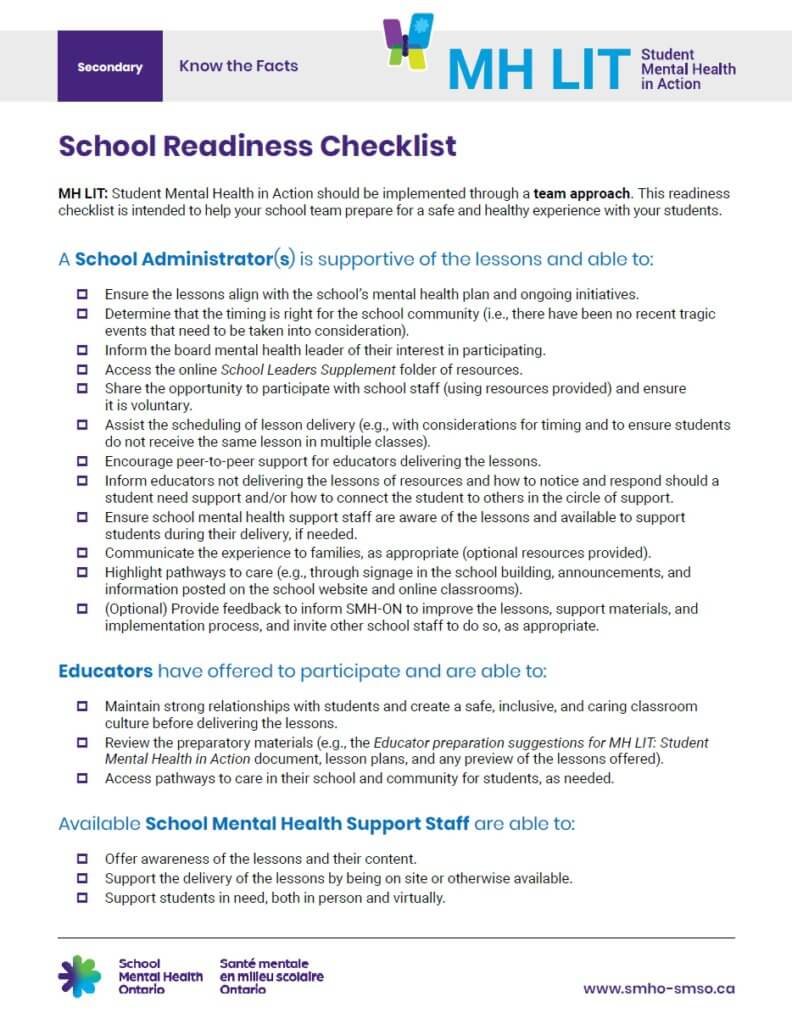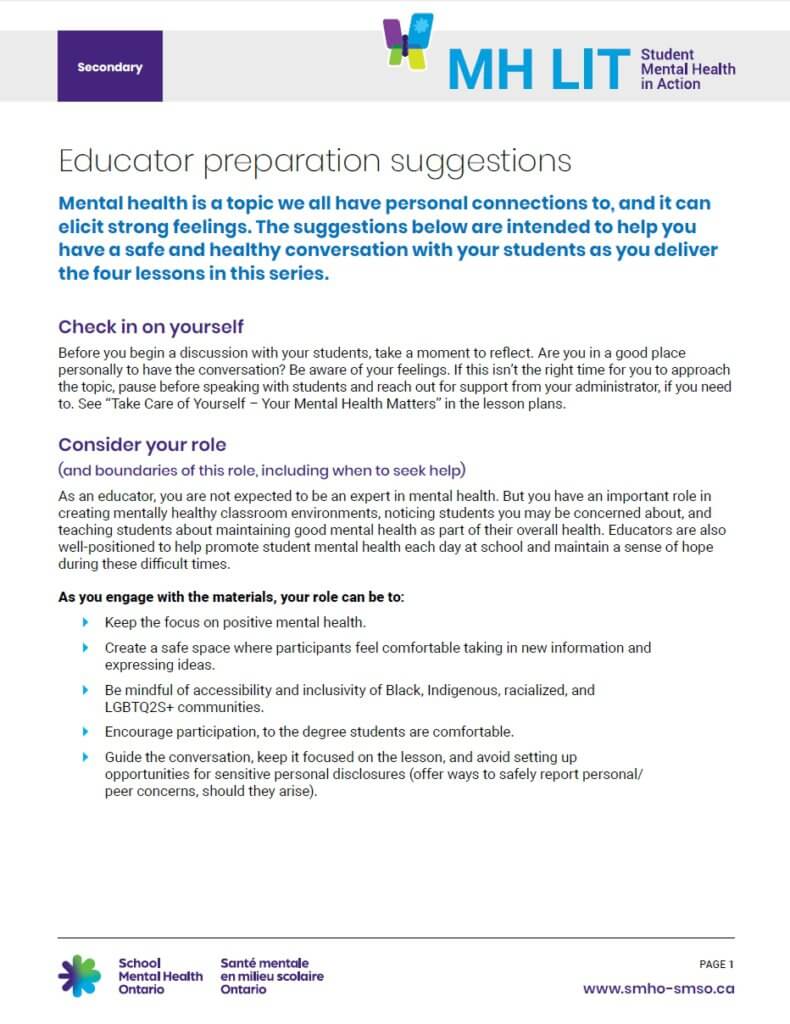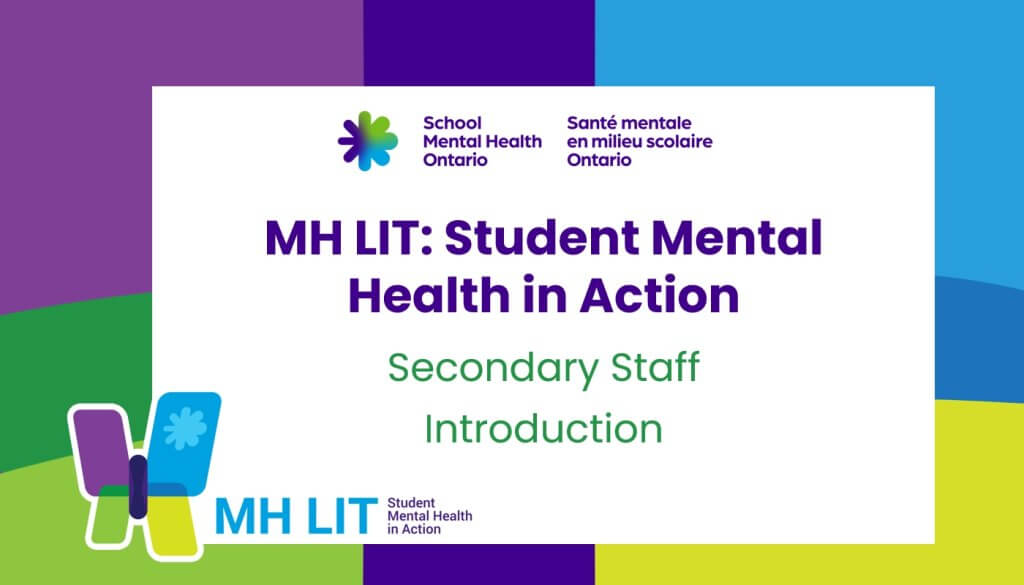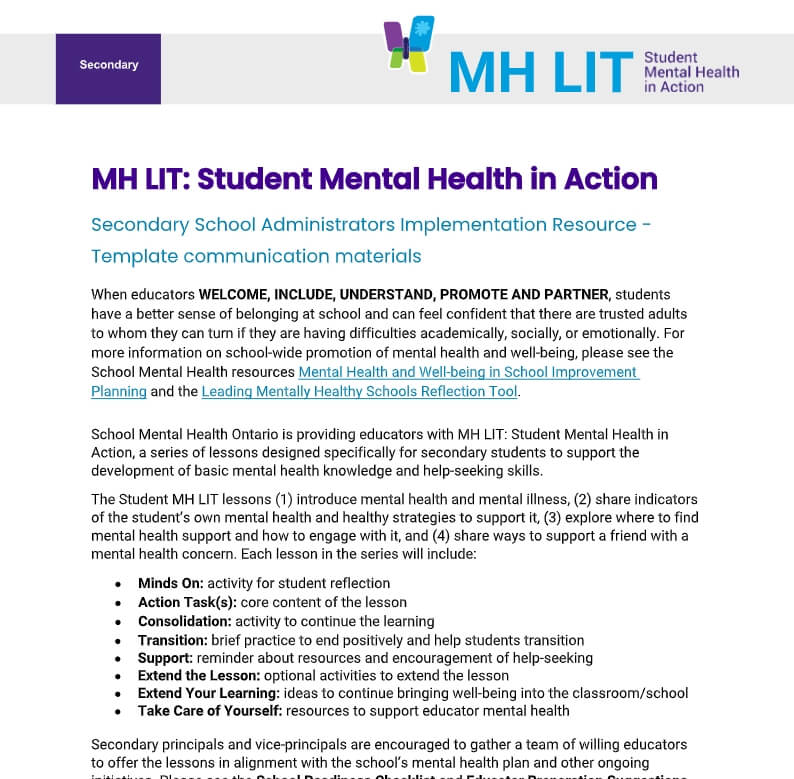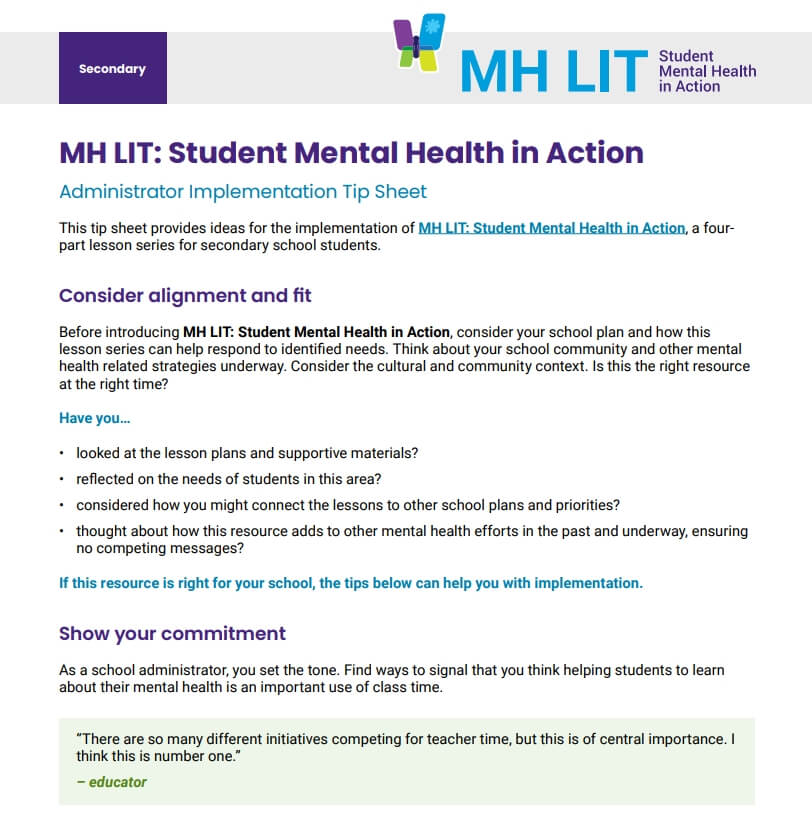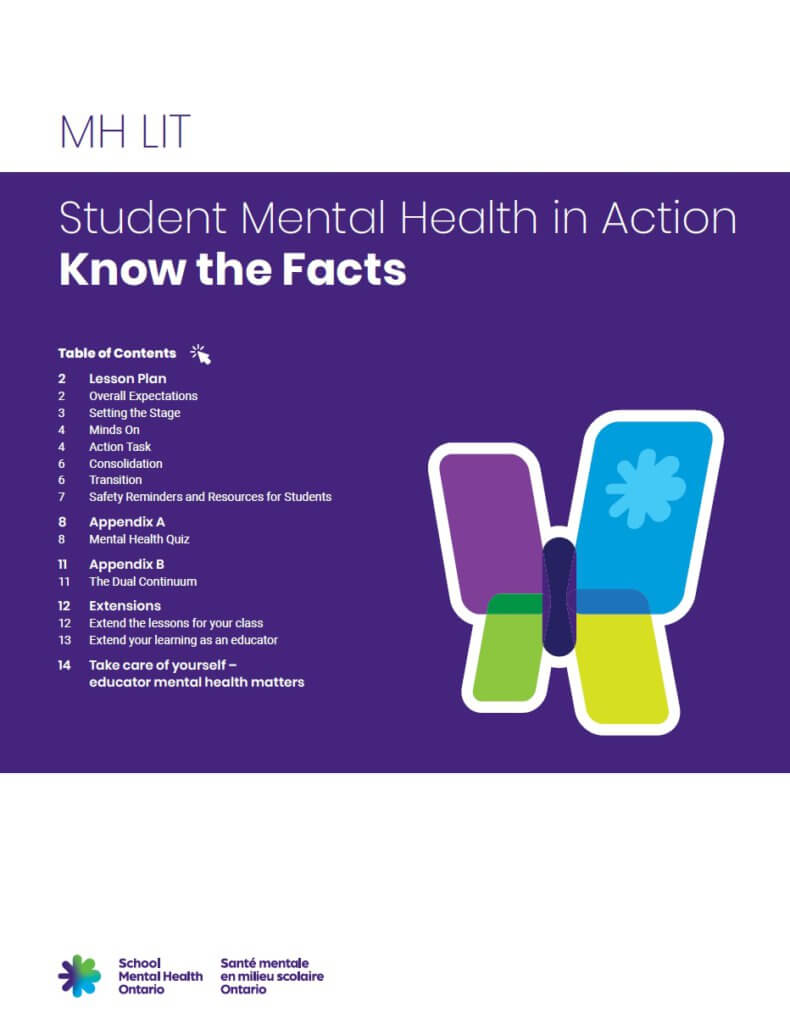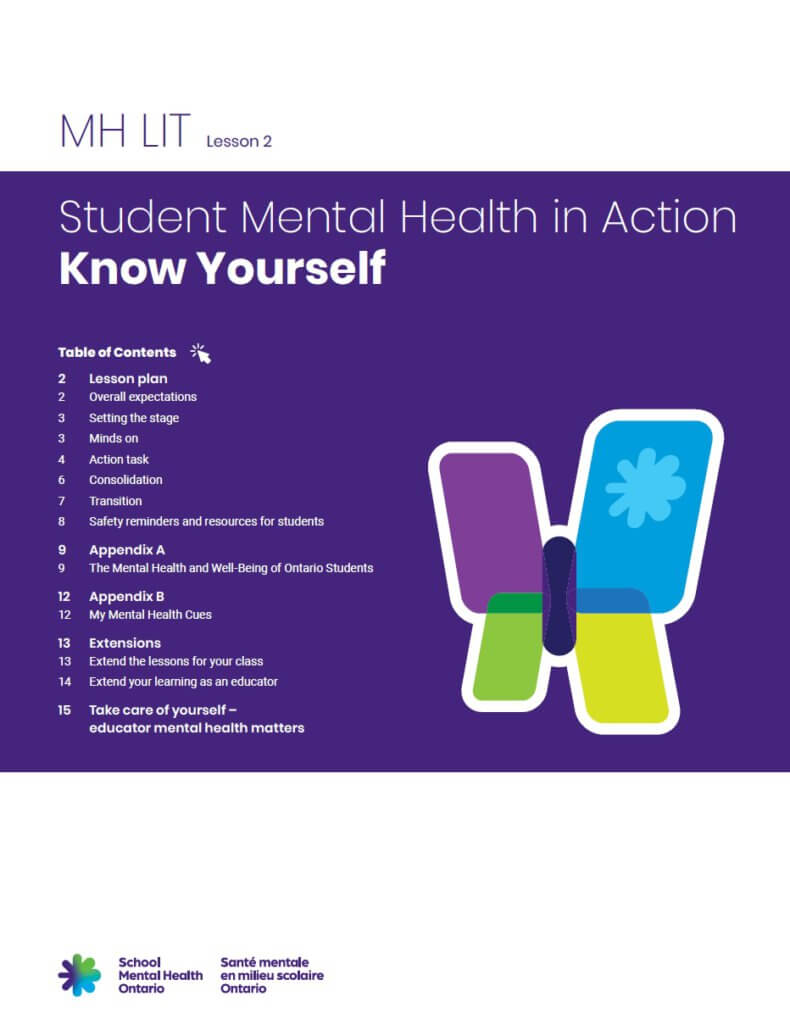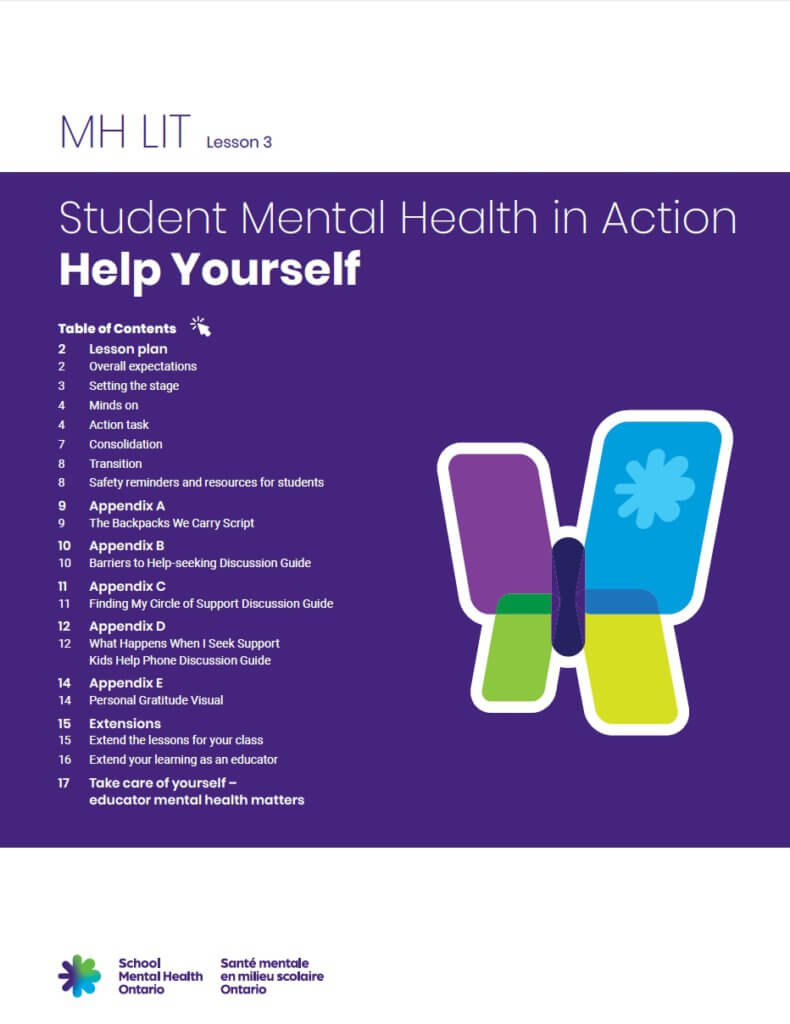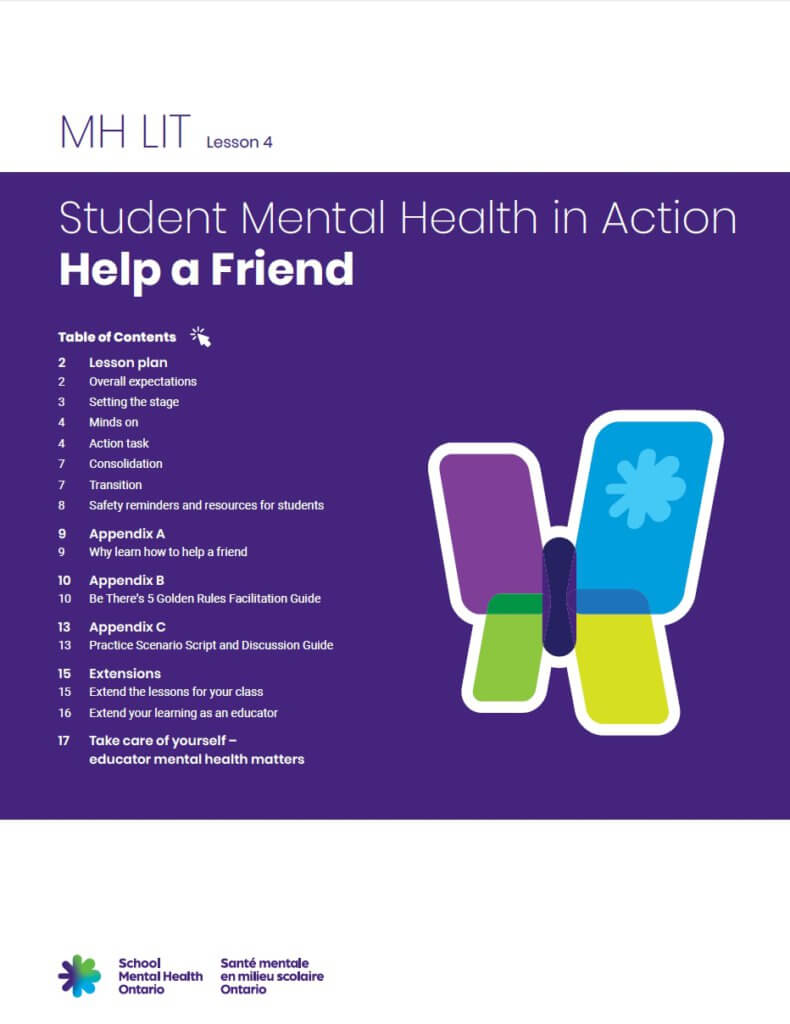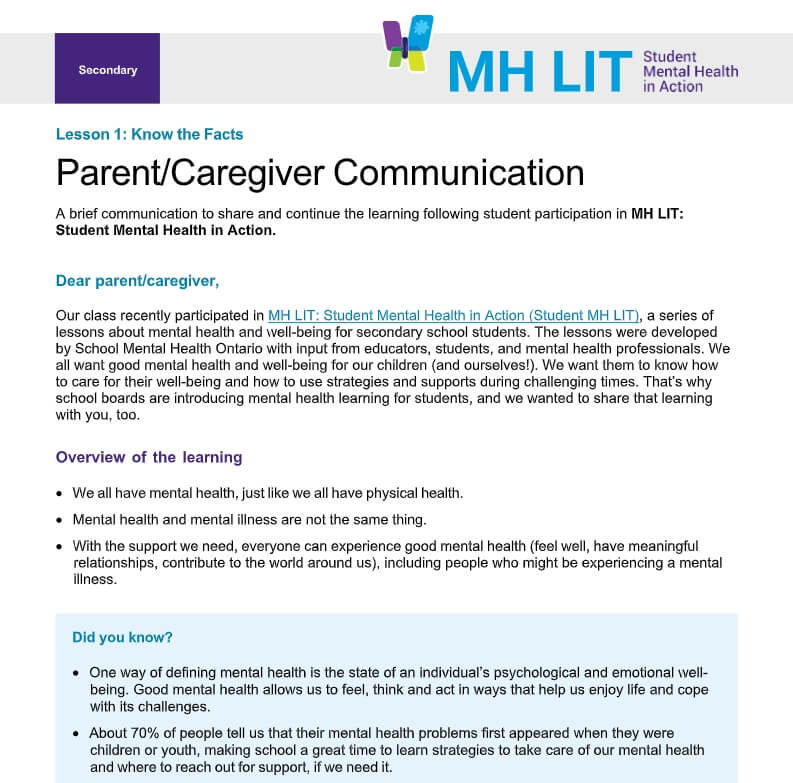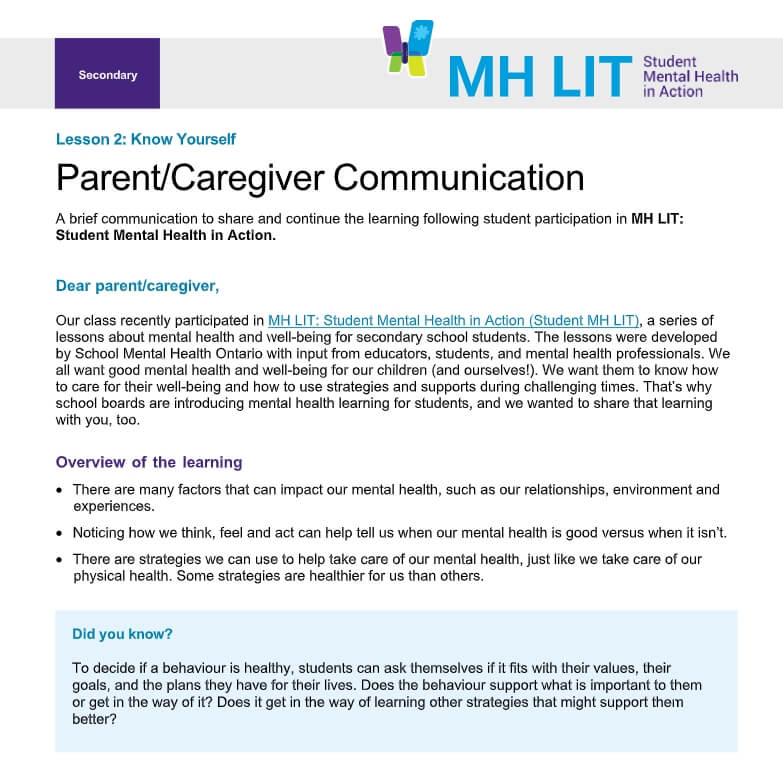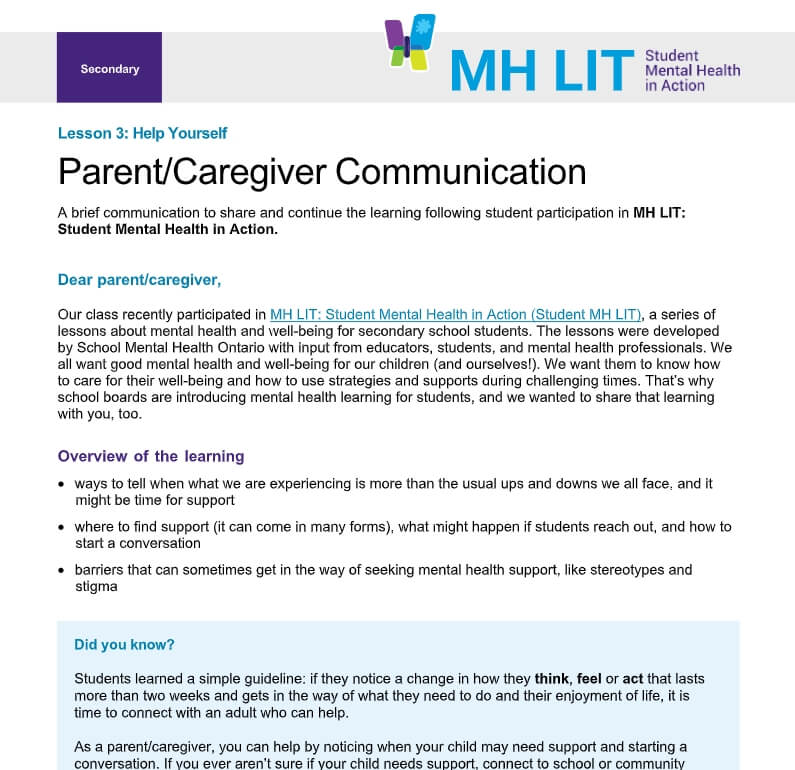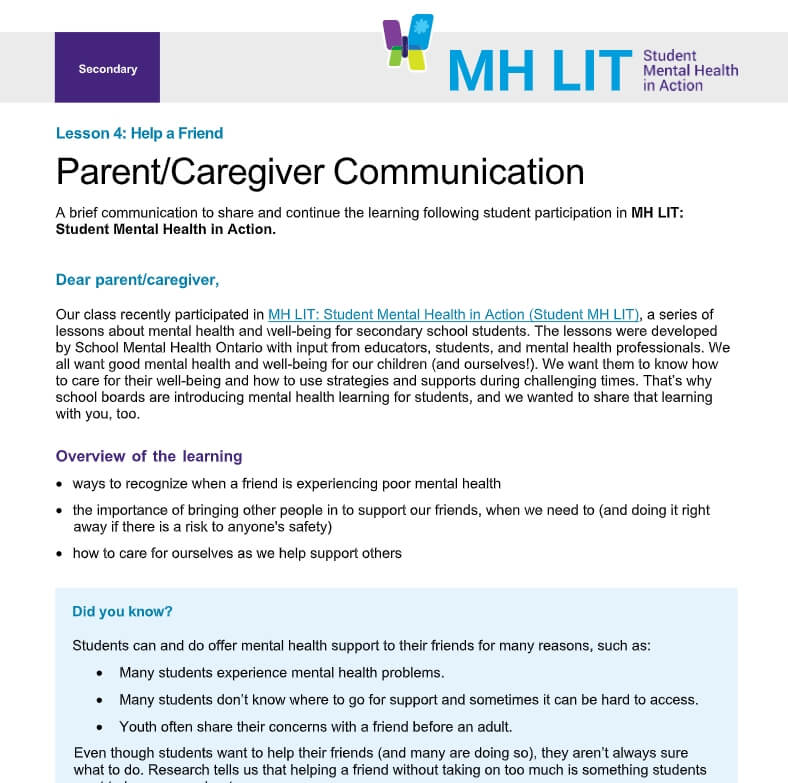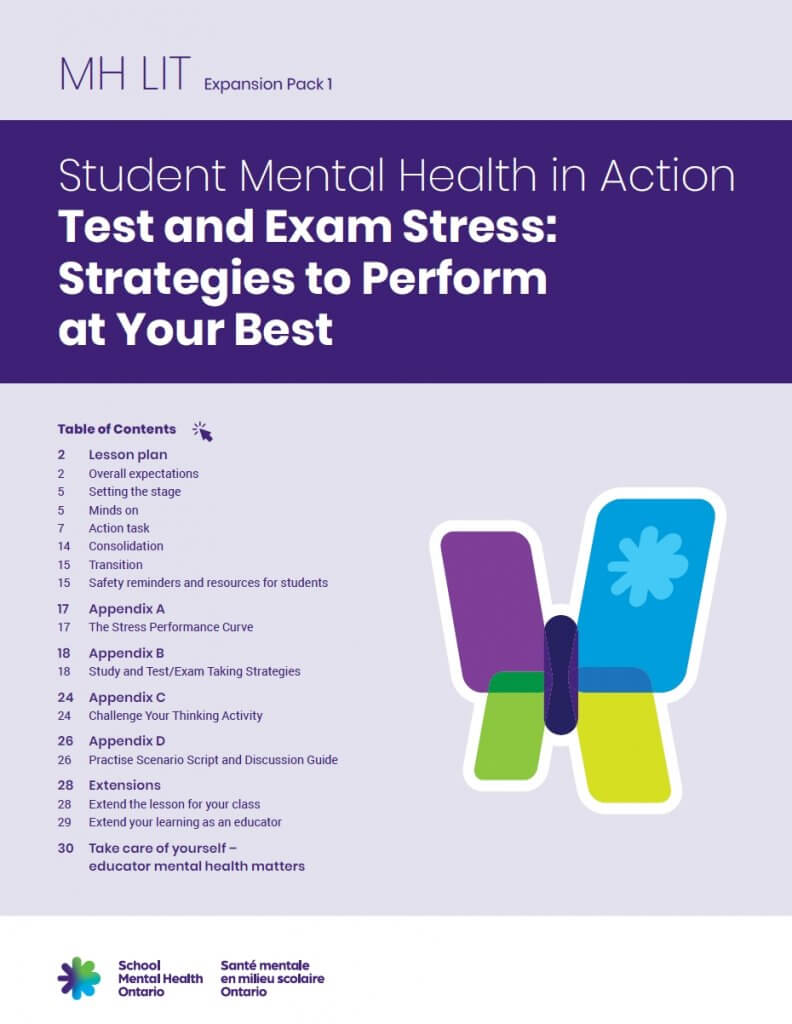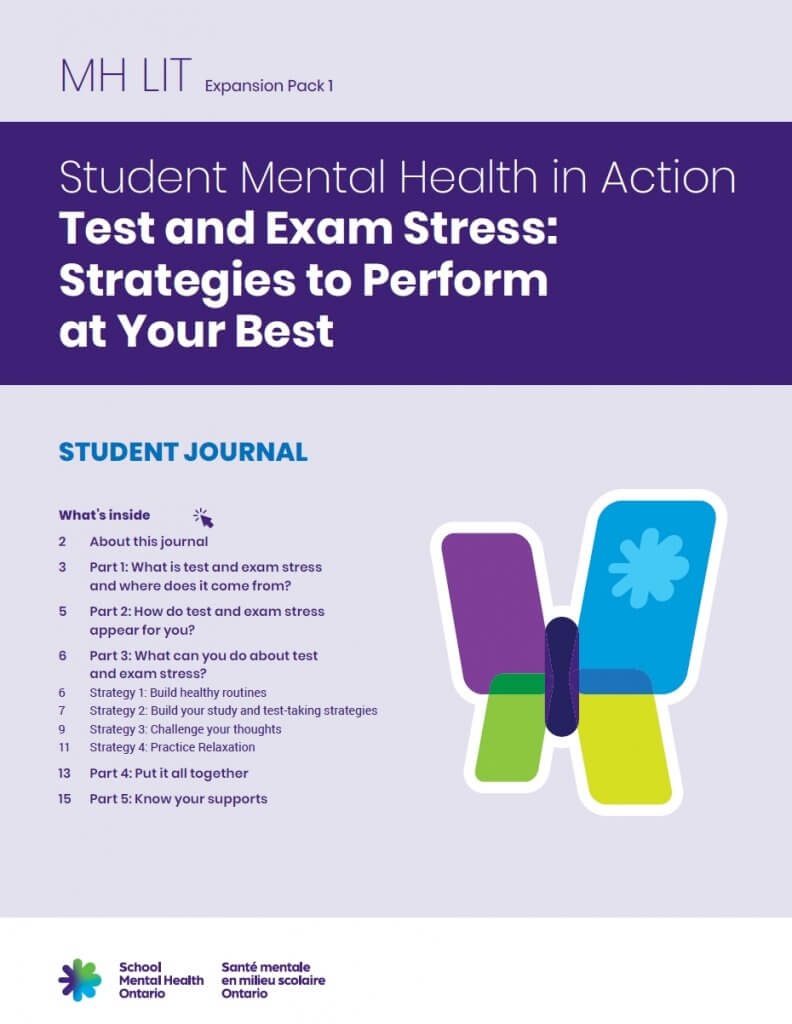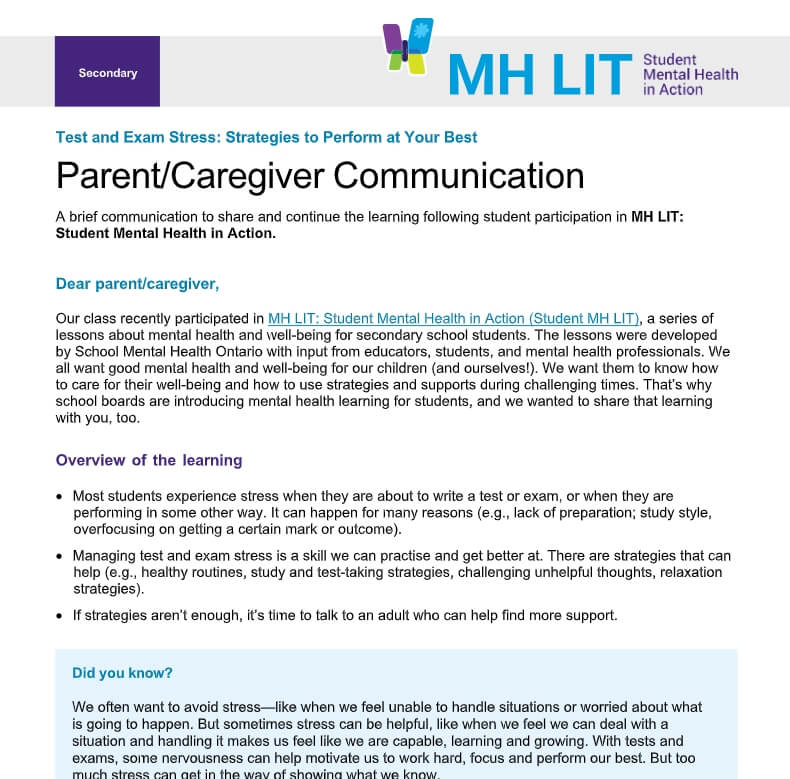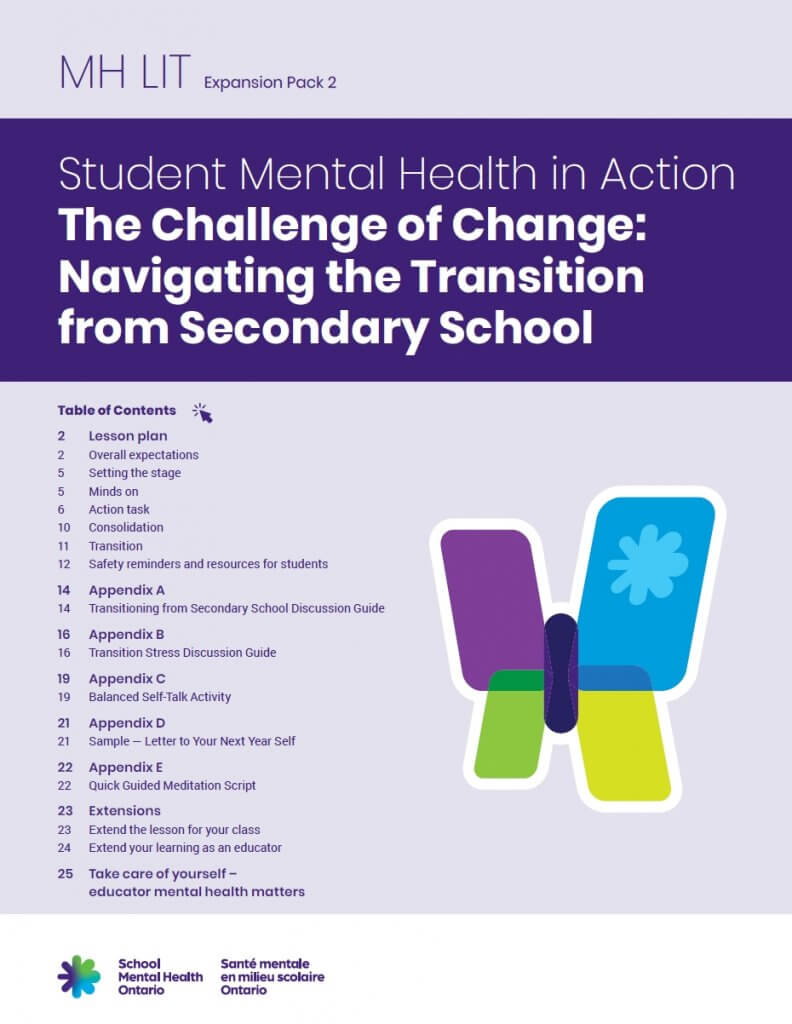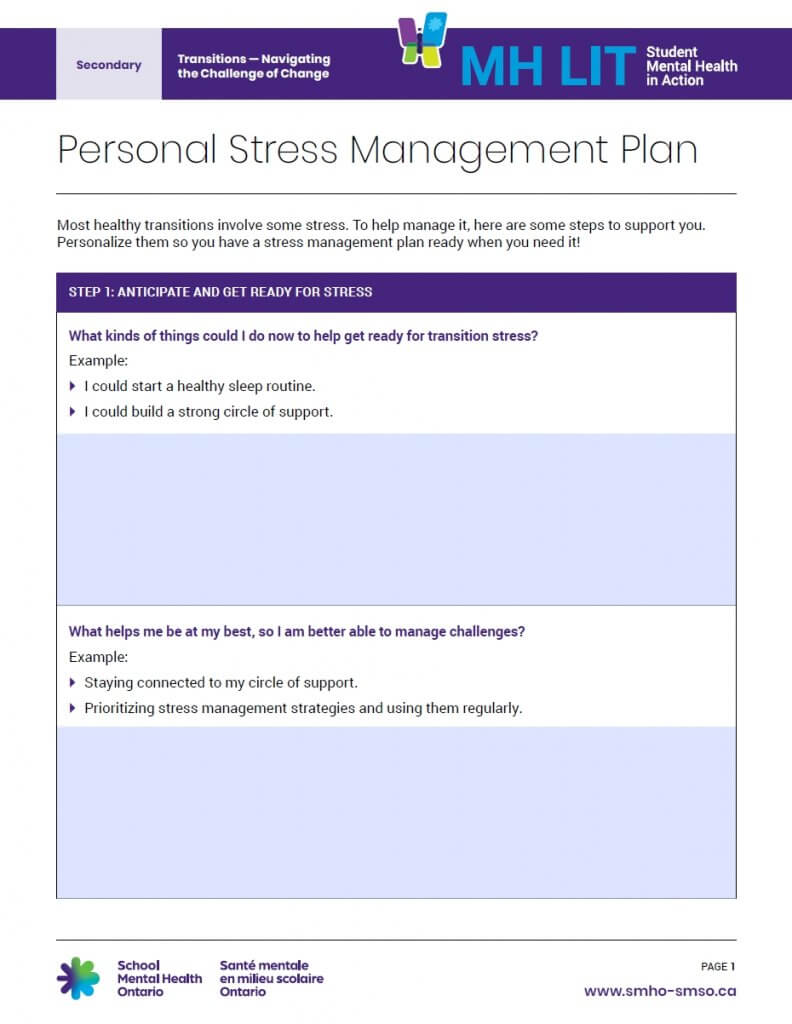MH LIT: Student Mental Health in Action
MH LIT: Student Mental Health in Action is a series of lessons to support the development of basic mental health knowledge and help-seeking skills. The lessons are designed for use with secondary students, focusing on building their understanding of mental health and mental illness, signs of mental health problems, and how/where to access help when needed.
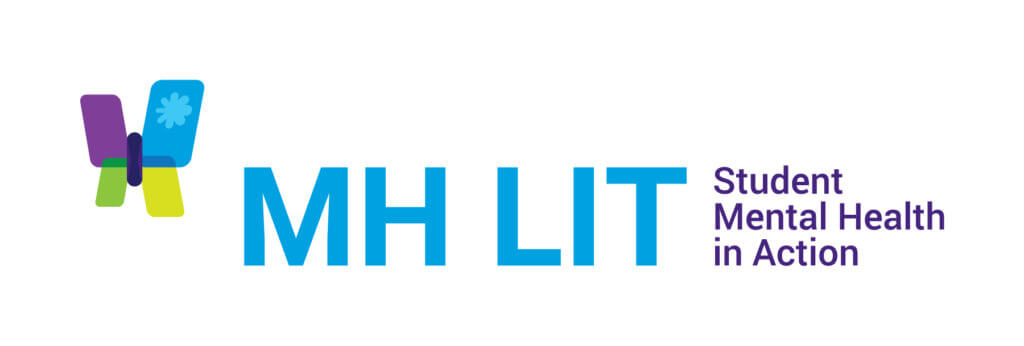
Welcome to MH LIT: Student Mental Health in Action
Looking for ways to support student mental health?
MH LIT: Student Mental Health in Action can help.
What is MH LIT: Student Mental Health in Action?
- Part of the Student Mental Health Action Kit
- Four secondary school lesson plans on mental health and help-seeking
Why bring lessons about mental health into the classroom?
- Encourage conversations
- Offer valuable learning experiences
- Promote student mental health and well-being
- Help students in need reach support
- Students want to learn about mental health in the classroom (#HearNowON 2019 report)
Student MH LIT is easy to use!
- Classroom ready for in-person and online learning
- Flexible
- Includes educator prompts and discussion guides
- Loaded with user-friendly click n’ play resources, like Kahoots and slide decks
Who helped develop it?
- Educators
- Administrators
- Students
- Mental health professionals
- Equity professionals
- Community partners
What are the lessons about?
- Lesson 1
- Know the Facts
- Basic mental health and mental illness information
- Lesson 2
- Know Yourself
- Indicators of mental health and healthy strategies to support it
- Lesson 3
- Help Yourself
- Where to find mental health support and how to connect with it
- Lesson 4
- Help a Friend
- Ways to support a friend with a mental health concern
- What’s the format?
It’s familiar!
Minds On
Activity for student reflection
Action Task(s)
Core content of the lesson
Consolidation
Activity to continue the learning
Transition
Brief practice to end positively and help students transition
Safety
Reminder about resources and encouragement of help-seeking
Extensions
Optional activities to extend the lesson or your own learning
Take Care of Yourself
Resources to support educator mental health
Wait, there’s more!
- A School Readiness Checklist
- Implementation materials for school leaders
- Educator preparation suggestions
- Parent/caregiver information sheets for each lesson
What do educators have to say about the lessons?
- The lessons were simple to deliver
- Educators felt equipped to offer them
- Regardless of the subject area, the lessons created a positive environment and prepared students to learn
If you engage with Student MH LIT, we’d love to hear from you!
There is a feedback form on the Student MH LIT web page.
[MH Lit Logo]
[SMH-ON Logo]
We work together with Ontario school districts to support student mental health
Nous travaillons en collaboration avec les conseils scolaires de l’Ontario pour favoriser la santé mentale des élèves
Smho-smso.ca
Each lesson includes
- Minds On: an activity for student reflection
- Action Task: engagement with the core content of the lesson
- Consolidation: activities for students to continue the learning
- Transition: a brief practice/activity to end in a positive way and help students transition to the rest of their day
- Safety: a reminder about available resources and encouragement of help-seeking
MH LIT: Student Mental Health in Action should be implemented through a team approach, including educators, mental health support staff and school leaders. SMH-ON has developed a School Readiness Checklist, Educator Preparation Suggestions, and a School Leader Supplement to support the implementation of the lesson plans.
Preparation materials
Implementation materials for school administrators
Lesson plans
Classroom resources
Lesson 3
- Finding My Circle of Support (Worksheet)
- My Circle of Support (Pocket guide)
- No Problem Too Big or Too Small (Help-seeking resource)
- Reaching Out (Tip sheet)
- Self-care 101 for Students (Tip sheet)
- Mental Health Literacy and Anxiety Management Social Media Bundles
- Class Conversation Starters (Classroom resource)
- Personal Gratitude Graphic (Appendix E, pg.14)
Parent/caregiver communication
Expansion packs
Test and exam stress
The Challenge of Change: Navigating the Transition from Secondary School
Connections to specific curriculum strands
The Arts
ADA10 - Drama, Grade 9, Open
A1.3 use role play to explore, develop, and represent themes, ideas, characters, feelings, and beliefs in producing drama works (e.g., use improvisation exercises to explore how they might think, feel, and act in specific real-life situations; write in role as a character who is reflecting on the people, events, and relationships affected by a personal, social, or environmental issue)
B2.2 explain how dramatic exploration can contribute to personal growth and self-understanding (e.g., explain how attributes such as self-awareness, empathy, confidence, and a willingness to take risks are developed and strengthened through drama activities; discuss the importance of the spoken word and rap to give voice to some cultures)
B3.2 identify specific social skills and personal characteristics they have acquired or strengthened through drama work that can help them succeed in other areas of life (e.g., describe their personal development in areas such as risk taking, self-confidence, self-awareness, listening, questioning, negotiating, consensus building)
ADA20 - Drama, Grade 10, Open
A1.3 use role play and characterization to explore personal and social issues (e.g., with a partner, create or assume a role that explores an issue such as bullying; create a scenario that reveals details about a character’s motivation)
B2.2 explain how dramatic exploration helps develop awareness of different roles and identities people have in society (e.g., explain what they learned through role playing characters from different socio-economic groups)
B3.2 identify skills they have developed through drama activities and explain how they can be useful in work and other social contexts (e.g., explain in a journal how their brainstorming and negotiation skills support teamwork in a variety of contexts)
ADA30 - Drama, Grade 11, Open
B2.2 identify ways in which drama can promote self- and social awareness (e.g., creating and performing can promote self-awareness, self-confidence, and personal growth; role playing can promote social understanding and increase one’s capacity for empathy)
ADA4E - Drama, Grade 12, Workplace Preparation
B2.2 identify ways in which drama activities strengthen their social and employability skills (e.g., by emphasizing skills and attitudes such as punctuality, acceptance of responsibility, ability to take direction, respect for others)
ADA3M - Drama, Grade 11, University/College Preparation
B2.2 identify ways in which drama can influence personal growth, relationships with others, and aesthetic judgement (e.g., issue-based and whole group drama activities can help develop empathy, self-knowledge, and social and environmental awareness; participation in the creative process can develop skills in applying aesthetic criteria to improve or evaluate a final product)
ADA4M - Drama, Grade 12, University/College Preparation
B2.2 describe ways in which their personal experiences in drama have influenced their attitudes to others and their own world view (e.g., by developing their empathy, respect for others, and group skills; by introducing them to customs and perspectives from other societies, time periods, and cultures)
Cooperative Education
DCO3O - Creating Opportunities through Co-op, Grade 11, Open
A1. Health, Safety, and Well-Being: demonstrate an understanding of legislation, practices, and behaviours related to health, safety, and well-being in connection with the cooperative education experience
A1.2 identify legislation, regulations, and policies, as well as various strategies and skills, that support well-being (including emotional safety) and the protection of human rights, and explain how they apply to the cooperative education experience (e.g., legislation, regulations, policies: Ontario’s Human Rights Code prohibits discrimination and harassment based on seventeen protected grounds, including race, creed, sex, sexual orientation, gender identity, and gender expression; the Occupational Health and Safety Act [OHSA] sets out the rights and duties of all parties in the workplace to protect workers from health and safety hazards on the job; the Freedom of Information and Protection of Privacy Act (FIPPA) protects confidentiality and the right to privacy; the Accessibility for Ontarians with Disabilities Act (AODA) sets accessibility standards in order to achieve accessibility for people with disabilities; the Employment Standards Act (ESA) requires that working conditions meet acceptable standards; strategies, skills: practices consistent with the acceptable use of technology; communication skills and strategies, including the appropriate way to respond to and report situations that make one feel uncomfortable or that are inappropriate; conflict resolution strategies; consulting with a trusted adult, such as a teacher, guidance counsellor, parent, or Elder – or in the case of adult students, a partner; using time management skills; setting priorities; appreciating differences among individuals)
B1. The Student’s Cooperative Education Learning Plan: develop, implement, and reflect on a learning plan, including learning related to health, safety, and well-being, to maximize success in the cooperative education experience
B1.2 actively and safely participate in the cooperative education experience as they implement their learning plan (e.g., show initiative – for instance, by offering to explore technological options that could enhance the organization’s customer surveys; ask questions to clarify their understanding of tasks and of how to perform them safely; observe and demonstrate appropriate practices and procedures for safety and well-being and for environmental protection; where appropriate, be prepared with the right tools, equipment, and/or materials; work collaboratively as part of a team; offer suggestions about using social media and other electronic means of communication, accommodating a variety of languages and formats where possible)
B2. Skills for the Future: demonstrate the skills and knowledge developed or refined through the cooperative education experience, including skills and knowledge related to health, safety, and well-being, and explain how they might use what they have learned in other aspects of their lives, now and in the future
B2.1 identify and describe the skills and knowledge they have developed through their cooperative education experience (e.g., critical thinking, problem-solving, creative and entrepreneurial thinking, time-management, technical, communication, and interpersonal skills; knowledge specific to the organization or sector; knowledge related to health, safety, and well-being, roles and responsibilities of workers, planning for their postsecondary endeavours; understanding of personal interests, strengths, and habits of mind), as well as how their cooperative education experience extended or enhanced the skills and knowledge gained in their related course (e.g., contributed to their growing mastery of skills developed in the related course; provided new insights into and perspectives on knowledge acquired in their related course; exposed them to real-life applications of what they learned in the related course, and to practical realities associated with that learning)
D1.2 identify, based on reflection, a range of factors that influence the decisions they make in connection with their cooperative education experience (e.g., individual goals, abilities, interests, and needs; family expectations; individual or school- or family-related responsibilities; cultural or religious values; environmental, ethical, social justice, and/or financial considerations; the opinion of peers; scheduling conflicts) (teacher prompt: “How might decisions that you make with respect to your cooperative education experience affect your overall personal well-being?”
English
EMS3O - Media Studies, Grade 11, Open
Understanding and Interpreting Media Texts
Purpose and Audience
1.1 identify and explain the purpose and audience of a variety of media texts (e.g., explain the purpose of a print advertisement and identify how the advertisement makes an emotional appeal to its audience; explain the purpose and audience of a website that promotes a healthy lifestyle; explain why a music video is an example of both entertainment and promotion; explain the purpose of paid product placements in film; identify the target audience of a campaign on workplace safety and explain their answer)
Message and Meaning
1.2 identify and explain the messages in and meanings of media texts (e.g., identify the messages conveyed about female body image in an advertisement for jeans; explain both the stated and implied meanings of an advertisement for mouthwash or deodorant; explain what the design of a hockey jersey implies about the team and about the person who wears the jersey; explain the overt message of an infomercial; explain the implied message in the front cover artwork and design of a science textbook)
Audience Responses
1.3 compare their own and others’ responses to a variety of media texts and explain how audiences’’ backgrounds affect the ways in which they negotiate meaning (e.g., compare and contrast their response to a music video with their parents’ responses; compare and contrast male and female reactions to various magazines; analyse how the ages and experience levels of computer users affect their use and enjoyment of a blog; explain why they have a different reaction to newspapers than their teachers do; describe how an individual’s interpretation of a text can be connected to social class or position; suggest how an employer and a Grade 9 student might react differently to advertisements that promote apprenticeship programs)
Media and Society
Individuals and Groups
1.1 analyse the representation of groups and individuals in media texts and comment on the perspectives, beliefs, or biases that are evident in the texts (e.g., create a collage of familiar stereotypes in fashion magazines and explain the overall impact of these images; compare media representations of workplaces, vacation experiences, or family life to their own experiences in those areas and suggest reasons for differences; discuss how the message of a popular television program would change if the main characters were from a different socio-economic or ethnic group; explain the effects of the inclusion, exclusion, or positioning of people or groups in magazine advertisements; compare the ways in which television shows, news stories, and advertisements depict the elderly and suggest reasons for differences among them)
Behaviours and Attitudes
1.2 analyse media representations of current social, political, and cultural issues and events, and explain how the representations might affect the audience’s interpretation of the issues (e.g., analyse media coverage of a war or uprising and explain how this coverage might affect the audience’s reaction to the conflict; assess the effectiveness of anti-smoking public service announcements for a teen audience; examine news coverage of Aboriginal communities and analyse the possible effect of the coverage on both Aboriginal and non-Aboriginal audiences; compare the coverage of current events in mainstream media with coverage in alternative periodicals, websites, or video documentaries)
1.3 analyse the representation of behaviours and attitudes in media texts and comment on how they influence the behaviours and attitudes of the audience (e.g., analyse the news coverage given to the achievements of a local hero; compare the attitudes depicted in a newspaper during a conflict with the attitudes in a feature film or television drama created after the conflict was resolved; evaluate the extent to which the reporting of an actor’s or athlete’s successes and failures influences popular opinion; examine how a celebrity’s homophobic or racist statement is treated in a tabloid newspaper and in an alternative newspaper, and identify reasons for differences)
Health and Relationships
2.2 analyse the impact of the media and of communication technologies on health, relationships, and interpersonal communications (e.g., compare the uses and effects of text messaging and face-to-face dialogue; assess the effects that eLearning has had on traditional schooling; analyse the effects of using documentaries and/or websites to support the curriculum in a health or leadership class; explain how public service announcements affect the way in which society views bullying; discuss ways in which the rise of online communities has changed the lives of people struggling with body image)
ETC3M - Canadian Literature, Grade 11, University/College Preparation
The Role of Literature in Society
Fostering Social, Cultural, and Political Awareness
5.1 explain how Canadian literary texts raise awareness about a variety of regional issues, ideas, cultures, events, and people (e.g., identify overt or implied positions on issues taken in texts; explain how the work of a favourite Canadian author has influenced their thinking about a social issue; identify works that have fuelled debate on a national level about a social, cultural, or political issue; explain the role of Canadian literary works in building understanding of the diversity of the population, and identify specific works that have contributed to such understanding)
Promoting Personal and Social Change
5.3 identify ways in which Canadian literary texts might promote social and personal change (e.g., use a graphic organizer to relate a conflict depicted in a text to the changing social or cultural values of its time; write and deliver a speech that a character from a contemporary text might make to spur an audience to social action; write an editorial recommending corrective action to remedy an abuse depicted in a text; use a graphic organizer to compare opposing depictions of a cultural group in texts from two different historical periods and suggest reasons for the differences; identify a text that depicts social or economic inequity and do research to determine whether the situation it describes has improved, and if so, in what way)
Developing Personal Awareness
5.5 explain how their study of Canadian literature has enhanced their understanding of themselves as readers and as individuals (e.g., explain in a journal entry how their ideas about an issue or theme have been influenced by their reading in the course; in a small group seminar, model a reading strategy that helped them understand and interpret a passage in a course text)
ETS4C - Studies in Literature, Grade 12, College Preparation
5. The Role of Literature in Society: assess the importance of literature as a social and cultural force.
Fostering Social, Cultural, and Political Awareness
5.1 explain how literary texts raise awareness about a range of topics, issues, ideas, cultures, events, and people (e.g., compare literary essays on a particular issue or topic written from different perspectives, describe the effect of the essays on their own thinking, and determine which view, if any, they are most likely to agree with; explain how a story by an Aboriginal writer affected their understanding of some of the current social and/or political concerns of Aboriginal peoples; read a text that discusses an international conflict and reflect, in a journal entry, on insights they have gained from the text into the causes of the conflict and/or the psychology of the opposing parties)
Promoting Personal and Social Change
5.3 identify ways in which literary texts might promote social and personal change (e.g., explain why a contemporary text is considered controversial; identify a controversial text from the past and explain why it is or is not still controversial today; design an advertising campaign to “sell” a point of view about an issue raised in a text they have read; write a “theme song” for a marginalized character depicted in a text they have read)
Exploring Human Nature
5.4 explain how the study of literature has contributed to their understanding of human nature (e.g., identify passages from literary texts that illustrate the capacity for forgiveness in human beings; identify a text that depicts human behaviour in difficult circumstances and comment on what they have learned from it, using words, visuals, or some other form of expression; use a Venn diagram to compare the views of human nature presented in texts by two different authors)
Developing Personal Awareness
5.5 explain how their study of literature has enhanced their understanding of themselves as readers and as individuals (e.g., identify and monitor the development of their reading skills in a reflective journal, and recognize their progress; identify fix-up strategies that they find most useful during reading; identify ways in which their own social and cultural contexts may enhance or limit their understanding of texts; in a literature circle, explain how a particular reading strategy helped them gain insight into a passage from a text; select a text that taught them a powerful life lesson and explain to a small group why it has particular meaning for them)
ETS4U - Studies in Literature, Grade 12, University Preparation
5. The Role of Literature in Society: assess the importance of literature as a social and cultural force.
Fostering Social, Cultural, and Political Awareness
5.1 explain how literary texts raise awareness about a range of topics, issues, ideas, cultures, events, and people (e.g., in a presentation to the class, describe how a particular literary text has altered their view of, or provided insight into, a social injustice, a contemporary issue, a cultural or religious conflict, or the legacy of an important historical figure; identify the issues addressed in a controversial literary text and explain how the text challenges social, cultural, or political norms with respect to those issues; identify texts they have studied that bring marginalized voices to the attention of a mainstream audience)
Promoting Personal and Social Change
5.3 identify ways in which literary texts might promote social and personal change (e.g., write and deliver a speech based on a famous example of political rhetoric to encourage an audience to take social action; write a journal entry about ways in which literature has inspired or might inspire people to change their minds or their behaviour; write an editorial, incorporating references from a text, recommending a remedy for an injustice depicted in the text)
Exploring Human Nature
5.4 explain how the study of literature has contributed to their understanding of human nature (e.g., in a class discussion, debate the validity of quotations about human nature found in texts studied in the course; relate the educational opportunities available to various characters in a novel to the characters’ moral, intellectual, or emotional development in the novel; identify similarities and differences in how myths from around the world portray human motivations and behaviour; identify, and share with the class, text passages that seem to capture or express some truth about human emotions such as loss, joy, pride, regret, or anticipation)
Developing Personal Awareness
5.5 explain how their study of literature has enhanced their understanding of themselves as readers and as individuals (e.g., explain in a journal entry how one or more literary texts have influenced their own world view; explain in a letter to a friend how a text has helped them to cope with a difficult situation; describe a life lesson they have learned from a text; share their reflections about the experience of studying literary texts with a group of younger students; in a class discussion, explain how their reading in the course has influenced their appreciation of a particular literary genre or historical period, or a particular author’s work)
First Nations, Métis, and Inuit Studies
NAC2O - First Nations, Métis, and Inuit in Canada, Grade 10, Open
B1.1 compare aspects of the way of life in some First Nations and Inuit societies prior to 1500 in different regions of what would be called North America (e.g., with reference to hunting, gathering, and agricultural societies; seasonal rhythms; gender constructs and roles; family life and childrearing; housing; spiritual beliefs; health and medicine; law and justice; values relating to wealth/prosperity and/or land and land ownership; knowledge transfer and education; community life; craft skills and production; practices related to birth, marriage, and death)
B2.2 analyse the key causes and consequences of the creation of the Haudenosaunee Confederacy (e.g., with reference to trade and the economy, community well-being, internal cooperation between member nations, external conflict with other nations, the role of The Peacemaker and Hiawatha)
B3.2 analyse ways in which social and political structures, including roles and kinship systems, of some First Nations and Inuit societies prior to 1500 in what would be called North America contributed to the identities and well-being of these societies and interrelationships in them (e.g., with respect to the roles of chiefs, council members, shamans, prophets, Elders, storytellers, sewers and garment makers, drum keepers, healers, warriors, hunters, gatherers, farmers; kinship systems such as clans; patrilineal and matrilineal societies)
E3.1 analyse various short- and long-term consequences of Indian residential school policy and the practices associated with it (e.g., short-term: disregard for parental rights, disruption of families, loss of knowledge of language and traditional culture, human experimentation, missing children, unrecorded burials in unmarked graves, sexual and physical abuse; long-term: trauma across generations, cultural assimilation and loss of identity, isolation from mainstream society and home communities, mental and physical health issues, the impact on the development of parenting skills and family bonding)
NBE3E - English: Understanding Contemporary First Nations, Métis, and Inuit Voices, Grade 11, Workplace Preparation
A1.6 compare a few perspectives on themes, ideas, and issues related to First Nations, Métis, and Inuit identities, relationships, and self-determination, sovereignty, or self-governance, as reflected in various texts from both Indigenous and non-Indigenous sources (e.g., compare the perspectives on the role of the extended family presented in a text by an Inuk author and one by a non-Indigenous author; after reviewing two or more texts, define success and well-being from a First Nations, Métis, or Inuit perspective and identify some similarities and differences with a non-Indigenous perspective)
E3.4 produce media texts on subject matter related to First Nations, Métis, and Inuit cultures, for several different purposes and audiences, using appropriate forms, conventions, and techniques (e.g., a webinar on First Nations, Métis, and Inuit diversity to explain the many nations represented by the student body; a public service announcement about on-reserve health and safety; packaging for a fashion line of T-shirts showcasing cultural symbols)
NBE3U - English: Understanding Contemporary First Nations, Métis, and Inuit Voices, Grade 11, University Preparation
E1.2 interpret media texts from First Nations, Métis, and Inuit cultures, and, as appropriate, relevant media texts from non-Indigenous sources, including increasingly complex or difficult texts, identifying and explaining the overt and implied messages they convey (e.g., identify some underlying social and/or political messages in a documentary on First Nations, Métis, or Inuit housing, access to clean drinking water, or mental health services, and explain how statistics are used to support those messages; identify the implied message about government legislation and Indigenous peoples in an online broadcast by a major Canadian news network and suggest possible reasons why the message is not openly expressed)
E1.3 evaluate how effectively information, themes, ideas, issues, and opinions are communicated in media texts from First Nations, Métis, and Inuit cultures, and, as appropriate, relevant media texts from non-Indigenous sources, including increasingly complex or difficult texts, and decide whether the texts achieve their intended purpose (e.g., determine whether a televised press conference about an initiative to improve health services to First Nations, Métis, and Inuit communities effectively communicated all the information needed by the target audience; assess the relative effectiveness of interviews with filmmakers and actors and interviews with film historians in the documentary Reel Injun)
NBV3C - World Views and Aspirations of First Nations, Métis, and Inuit Communities in Canada, Grade 11, College Preparation
C2 Decolonization, Resilience, and Social Change: demonstrate an understanding of the key concepts and goals of decolonization and resilience, analysing various strategies to raise awareness of the impact of colonialist policies and to sustain First Nations, Métis, and Inuit world views, aspirations, and actions in the context of social change.
C2.1 explain the significance for Indigenous and non-Indigenous individuals in Canada of the key concepts and goals associated with decolonization and resilience in the context of social change (e.g., societal acceptance of responsibility for the continuing consequences of colonization enables First Nations, Métis, and Inuit individuals to feel understood and respected; consultations to develop new political and social policies encourage Indigenous community members to participate in societal change; incorporating First Nations, Métis, and Inuit perspectives into contemporary public institutions gives Indigenous citizens a voice in Canadian society; learning about the goals of decolonization helps both Indigenous and non-Indigenous individuals understand the history of Canada and all its peoples; improving educational attainment supports First Nations, Métis, and Inuit individual and community aspirations and addresses inequality of opportunity; revitalizing Indigenous languages supports individual and collective cultural identity)
C2.2 analyse several different initiatives to raise awareness of the continuing impact of colonialist policies in Canada in terms of the motivations, methods, and results of these efforts (e.g., with reference to processes and consultations with Indigenous governments to address issues related to child welfare, education, justice, economic opportunity and fairness, environmental protection, political representation, health; social media movements and campaigns; public art projects that advocate for social justice; forms of protest and resilience such as teach-ins, fasts, demonstrations, and blockades; legal action)
D1.2 analyse several different strategies to integrate traditional knowledge and customs into contemporary life for First Nations, Métis, and Inuit individuals and communities to identify benefits and challenges related to these efforts (e.g., benefits: providing some community schools and offices with the opportunity to offer cultural leave enables Indigenous youth and adults to maintain their cultural identity by participating in traditional customs; supporting the use of traditional medicines, knowledge, and health practices as part of a comprehensive approach to health care for urban Indigenous individuals can improve physical and psychological well-being; challenges: individuals who seek cultural knowledge or wish to learn a language based on their ancestry may have insufficient access to relevant programming; mainstream institutions may find it difficult to accommodate cultural leave related to seasonal activities; traditional hunting practices may conflict with non-Indigenous approaches to animal rights and/or animal husbandry)
NBV3E - World Views and Aspirations of First Nations, Métis, and Inuit Communities in Canada, Grade 11, Workplace Preparation
C2 Decolonization, Resilience, and Social Change: demonstrate an understanding of the key concepts and goals of decolonization and resilience, analysing various strategies to raise awareness of the impact of colonialist policies and to sustain First Nations, Métis, and Inuit world views, aspirations, and actions in the context of social change
C2.1 demonstrate an understanding of the key goals of decolonization and resilience in the context of social change (e.g., acknowledging the continuing effects of colonization; incorporating Indigenous perspectives into contemporary public policies; recognizing and respecting contemporary First Nations, Métis, and Inuit world views, aspirations, and actions; honouring treaty agreements; acknowledging the resilience of Indigenous communities, grassroots organizations, and youth, and supporting their role in shaping new societal perspectives; ensuring the quality of life of current and future generations; improving educational attainment; revitalizing culture and language; achieving self-determination through respectful relationships between Canadian governments and distinct Indigenous governments)
NDA3M - Contemporary First Nations, Métis, and Inuit Issues and Perspectives, Grade 11, University/College Preparation
B3.2 make inferences about the ways in which various forms of racism and cultural stereotyping have affected and continue to affect First Nations, Métis, and Inuit individuals and communities, drawing on political, social, and/or economic evidence to support their conclusions (e.g., intolerance of and prejudice against two-spirited Indigenous individuals; stereotypical depictions of Indigenous peoples in sports team names and insignia; racial profiling; barriers to employment and/or social services such as appropriate medical treatment and education; incarceration rates; political inattention to discrimination affecting Indigenous women)
C1.2 identify and explain the significance of various contemporary economic issues and/or developments relating to First Nations, Métis, and Inuit community-planning initiatives (e.g., the exercise of traditional hunting and gathering rights; the continuing implications of the Jay Treaty for the movement of resources across borders; community taxation structures; participation in the First Nations Land Management Regime; investment in public health and social services and in infrastructure such as recreational and cultural facilities; economic diversification and support for small businesses; the development of economic strategies such as the 2008 Anishinabek Economy: Our Economic Blueprint)
C1.3 identify and explain the significance of various contemporary social issues, perspectives, and/or developments related to education and training in connection with First Nations, Métis, and Inuit communities (e.g., the multigenerational legacy of the residential school system; social programming and services for First Nations, Métis, and Inuit postsecondary students; funding for on-reserve schools; increasing awareness of the relationship between individual/community health and well-being and educational achievement; the shift towards including traditional approaches in teaching about protecting the environment and biodiversity; the dichotomy between Eurocentric and Indigenous approaches to education; the potential for culture shock when relocating from a rural to an urban community to access education)
C2.1 analyse the impact on Canadian society of various contemporary socio-demographic trends and issues related to First Nations, Métis, and Inuit communities (e.g., with reference to housing and infrastructure on reserves, community planning and development, education, careers, health, justice, cultural awareness, population growth and rural-to-urban migration)
C2.3 suggest a variety of ways in which effective leadership can contribute to the realization of First Nations, Métis, and Inuit community aspirations, drawing on evidence from communities in different regions of Canada (e.g., with reference to language revitalization, cultural revitalization and/or cultural continuity, educational attainment, healthy lifestyles, community prosperity)
NDG4M - First Nations, Métis, and Inuit Governance in Canada, Grade 12, University/College Preparation
D3.3 analyse some of the calls to action in the Final Report of the Truth and Reconciliation Commission of Canada (e.g., with respect to child welfare, education, language and culture, health, justice), with particular reference to call to action number 45, to reaffirm the “nation-to-nation relationship between Aboriginal peoples and the Crown”
NDW4M - Contemporary Indigenous Issues and Perspectives in a Global Context, Grade 12, University/College Preparation
B1.3 compare the sociocultural/socio-political practices of Indigenous peoples in several different regions of the world to identify similarities and differences in the world views that these practices reflect and express (e.g., with reference to the transmission of cultural heritage, social relations and observances, economic organization and practices, political structures and governance approaches, relationships with the environment, approaches to health and wellness)
C2.1 describe key human rights challenges faced by Indigenous peoples around the world (e.g., loss of ancestral land, including through forcible removal and relocation; inadequate access to resources/services such as traditional food, clean water, and sanitation; use and/or degradation of natural resources on Indigenous territories; inadequate housing; vulnerability to poverty; lower levels of literacy; limited access to health services; forced assimilation; lack of self-determination; lack of government support for Indigenous laws and traditions; inadequate protection of cultural and intellectual property such as environmental knowledge; violence against community members who attempt to defend Indigenous rights; loss of language and/or culture), and explain some connections between human rights, living conditions, and way of life
D2.1 describe and compare the roles of legislative and judicial branches of government in protecting the rights of Indigenous citizens (e.g., with reference to the establishment of judicial councils in countries such as Ecuador and Paraguay; constitutional reforms recognizing Indigenous peoples’ right to be subject to customary law; legislative versus judicial protections for commonly held lands; legislative definitions of the role and responsibilities of government with respect to Indigenous education and health)
French As A Second Language (Core, Extended French, French Immersion)
FEF4U - Extended French, Grade 12, University Preparation
Listening
A1.3 Responding to and Evaluating Media Texts: evaluate the effectiveness of the treatment and presentation of ideas and information in a variety of oral media texts in French, including some challenging texts, about a wide variety of topics (e.g., view the trailer for a film they have already seen and evaluate how well it reflects and promotes the film; analyse the language in a news broadcast for overgeneralizations or stereotypes about race, gender, culture, or ability; explain how humour is used in video clips to communicate an underlying message; analyse the interviewing style of a radio personality and its appeal for the target audience; analyse the perspective of a documentary about economic development and the environment in Canada and evaluate its objectivity; explain how public service announcements promote mental health awareness in their own and another community)
FIF3O - French Immersion, Grade 11, Open
Writing
D1.2 Writing in a Variety of Forms: write a variety of French texts to convey information, ideas, and opinions about a variety of topics, applying their knowledge of the structural and stylistic elements of each form (e.g., dialogue for a role play; a photo essay with a series of powerful images and captions promoting diversity and inclusion; a chart describing postsecondary options; a research paper describing professions in which the ability to speak French would be an asset; an essay detailing their personal development or explaining how some of their activities, hobbies, or pastimes contribute to their family or community; an article for a community newspaper about an initiative to create and sustain conditions that support health and well-being in the community)
FSF3U - Core French, Grade 11, University Preparation
Reading
C1.2 Reading for Meaning: demonstrate an understanding of explicit and implicit messages in a variety of student- and teacher-selected French texts about academic and personally relevant topics (e.g., identify the intent or point of view of the writer of an article in a newspaper or magazine or on a website, and share their reaction to the article with their peers; compare and contrast the points of view presented in different articles or reports on the same issue; create a glossary of key terms used in texts on a specific issue; summarize texts to compare information about mental health and mental illness; develop a list of questions for a mock interview with a character from or the author of a text; analyse texts in terms of information, ideas, or themes relevant to the issue under study)
Guidance and Career Education
GLC20 - Career Studies, Grade 10
A1.1 demonstrate an understanding of the importance of resilience and perseverance in school, life, and work – why it is helpful to acquire skills for adapting to change, persevering in the face of adversity, learning from mistakes, and thinking positively about setbacks – and analyse how developing resilience and perseverance can help them in all areas of their lives
A1.2 identify a range of strategies to help manage stress and achieve and maintain a healthy school/life/work balance, and explain how they have used such strategies in their lives so far and how they might apply them in the future
B2.2 identify factors and conditions other than an individual’s strengths, interests, and needs that inform education and career/life choices, and explain which of these factors may be influencing their own decisions
GLS1O/GLE1O/GLE2O - Learning Strategies 1: Skills for Success in Secondary School, Grade 9, Open
Personal Knowledge and Management Skills
- identify and describe personal lifestyle strategies that enhance health and wellness and improve one’s readiness to learn (e.g., exercising regularly, getting enough rest, following a nutritious diet, maintaining a balance among priorities; adopting holistic approaches to well-being, such as those found in Aboriginal cultures);
- identify internal and external factors that affect behaviour and school performance (e.g., emotional stress, motivation, racism, peer attitudes, exclusion, physical distractions), and identify strategies for improving behaviour to enhance learning
- explain how stress can positively and negatively affect learning performance (e.g., with regard to test taking and work completion), and demonstrate effective use of stress-management techniques to maximize performance.
GLS4O/GLE4O/GLE3O - Advanced Learning Strategies: Skills for Success After Secondary School, Grade 12, Open
Personal Management
- identify and describe personal factors that can negatively affect their learning and thinking (e.g., low self-esteem, high anxiety, substance abuse, poor interpersonal skills, family relationships)
- describe the personal and social factors that contribute to positive and negative stress (e.g., disabilities, racism, discrimination, financial situation, family support), and explain how stress affects them in a variety of settings (e.g., school, family, workplace, peer group)
- explain the relationship between a healthy lifestyle (e.g., adequate sleep, good nutrition, regular exercise; holistic approaches to well-being, such as those found in Aboriginal cultures) and daily performance in various settings
- assess their affective preparedness (e.g., sense of responsibility, independence, emotional readiness) for their postsecondary education or work goals
GPP3O - Leadership and Peer Support, Grade 11, Open
Personal Knowledge and Management Skills:
Personal Management
- demonstrate an understanding and appropriate application of the principles and protocols related to confidentiality and privacy rights (e.g., referral of an issue to the appropriate teacher or department) in a variety of leadership and peer support roles;
Strategies and Resources
- identify and describe challenges (e.g., emotional, motivational, learning, socio-economic, family-related) to effective learning and goal achievement;
- explain how to recognize challenges to learning in others and how to determine their own role in helping others address these challenges;
- describe school and community support programs and services (e.g., guidance services, social service agencies, cultural and religious organizations, mentorship programs available to support students’ needs) and explain how to access them
Interpersonal Knowledge and Skills:
- demonstrate an understanding of how to respond appropriately (e.g., remaining calm, empathizing, recommending a referral) to peers’ disclosures of serious personal matters (e.g., health problems, physical and emotional abuse, bullying, exclusion, discrimination, family issues, harassment, substance abuse)
Health and Physical Education
PLF4M - Recreation and Healthy Active Living Leadership, Grade 12, University/College Preparation
B1. Promotion of Lifelong Participation
B1.1 explain the terms active recreation and healthy leisure, and describe the potential social, economic, and environmental benefits that active recreation and healthy leisure can provide for a community (e.g., social: enhancement of family and other social bonds, promotion of empathy and equity, reduction of isolation and alienation through participation in shared activities; economic: employment, reduction of health care costs and productivity losses; environmental: reduction of carbon emissions and emissions of other air pollutants through use of active transportation)
B1.2 explain why lifelong participation in active recreation and healthy leisure is an important contributor to one’s quality of life and well-being (e.g., improves and maintains personal health-related fitness; helps prevent or manage chronic disease; has a positive influence on mental health; creates time for family bonding; improves social networking and creates opportunities for developing and strengthening personal relationships)
B1.3 describe motivational factors (e.g., physical health benefits, stress management benefits, enjoyment, opportunities for learning new skills, social interaction) and potential challenges (e.g., financial constraints; lack of programs; lack of facilities or poor access to facilities; transportation difficulties; restrictions related to family values, social, or cultural norms; language barriers; low level of fitness; poor environmental conditions) that affect lifelong participation in active recreation and healthy leisure, and identify strategies for overcoming these challenges (e.g., overcome financial and time constraints by identifying inexpensive and convenient recreational resources within the community, such as community education or recreation programs and worksite programs, or by planning social activities that involve physical activity)
C2. Healthy Active Living Plan
C2.1 describe how healthier choices related to physical activity, healthy eating, and other aspects of everyday living (e.g., limiting screen time and increasing participation in a variety of physical activities that provide cardiovascular and muscular endurance, muscular strength, or flexibility benefits; eating balanced meals; choosing nutritious snacks; managing stress; getting enough sleep; making choices with personal safety in mind) contribute to better physical, mental, and social health and greater personal well-being
C2.5 identify community resources and support services related to physical activity, healthy eating, and personal well-being (e.g., public health units, credible and accurate websites, youth centres, recreation centres)
PPL1O - Healthy Active Living Education, Grade 9, Open
Personal Safety and Injury Prevention
C3.2 identify warning signs and symptoms that could be related to mental health concerns
PPL2O - Healthy Active Living Education, Grade 10, Open
Personal Safety and Injury Prevention
C1.1 demonstrate an understanding of factors that enhance mental health and emotional and spiritual well-being [PS, IS]
PPL3O - Healthy Active Living Education, Grade 11, Open
Substance Use, Addictions, and Related Behaviours
C2.2 apply their understanding of the connections between substance use, addictive behaviours, and physical and mental health
C3.5 describe factors that contribute to the stigmatization of mental illness (e.g., myths about the causes of mental illness; insensitive use of language; fear of violent, unpredictable, or embarrassing behaviour), and identify strategies that could be used to reduce stigma in their local community [PS, IS, CT]
PPL4O - Healthy Active Living Education, Grade 12, Open
Living Skills – Personal Skills
1.1 use self-awareness and self-monitoring skills to help them understand their strengths and needs, recognize sources of stress, take responsibility for their actions, and monitor their own progress as they participate in physical activities, develop movement competence, and acquire knowledge and skills related to healthy living (e.g., Active Living: explain how doing a self-inventory related to lifelong wellness and active living will help to determine priorities to be addressed in the development of their fitness and physical activity plans; Movement Competence: monitor improvements in their body control while participating in various locomotor and stability activities; Healthy Living: explain how having a good understanding of their personal needs in terms of nutrition, budget, and daily routines can be helpful when planning for healthy eating)
Healthy Living – Making Healthy Choices
C2.3 describe how coping and interpersonal skills and their knowledge of personal protective and risk factors can be used to develop resilience and enhance their ability to make healthy choices, including the avoidance of substance use and addictive behaviours [PS, IS, CT]
C2.5 identify the skills and resources that they will need to maintain their personal health and well-being as they become more independent (e.g., budgeting and time-management skills, interpersonal skills, cooking and meal-planning skills, recreational and leisure opportunities, access to health care and other supports) [PS, CT]
There are also broad general connections: “Students also acquire an understanding of the factors and skills that contribute to healthy development and learn how their own well-being is affected by, and affects, the world around them.”
PPZ3C - Health for Life, Grade 11, College Preparation
Personal Factors
A1.2 demonstrate an understanding of resilience and its impact on personal health, and explain how personal factors (e.g., ability to self-monitor, self-awareness, assertiveness, ability to solve problems, coping skills, empathy and compassion, sense of humour, good physical and mental health, having goals and aspirations) contribute to the development of resilience
Wellness
B1.2 describe the factors that contribute to personal wellness and support healthy living (e.g., sense of responsibility; ability to make decisions related to physical activity, fitness, and healthy eating; healthy relationships; coping skills; creative and critical thinking skills; a positive sense of self)
Components of Healthy Communities
C2.2 identify and describe school and community services that offer support related to health and wellness (e.g., public health units, community agencies, friendship centres, mental health facilities)
Promoting Healthy Living
C3.1 describe actions that individuals can take that contribute to the health of others
C3.2 demonstrate an understanding of the concept of health promotion, and describe strategies and skills that can be used to promote healthy living in their school community
C3.5 describe career opportunities in fields related to health and wellness (e.g., paramedic, workplace wellness administrator, health and safety officer, social services worker, drinking water treatment and distribution operator, environmental health officer, public health inspector, public health nurse)
PSK4U - Introductory Kinesiology, Grade 12, University Preparation
A2. Participation – Influences and Benefits
A2.3 describe the benefits of school and community physical activity and sports programs for themselves and for society (e.g., increased opportunity for participation; increased fitness and better overall health; decreased stress, higher self-esteem, better mood, and generally improved mental health and well-being; better cognitive functioning; better school spirit; increased community cohesion; lower crime rates; lower health care costs; better workplace performance; decreased absenteeism)
Mathematics
MDM4U - Mathematics of Data Management, Grade 12, University Preparation
1.1 recognize and describe the role of data in statistical studies (e.g., the use of statistical techniques to extract or mine knowledge of relationships from data), describe examples of applications of statistical studies (e.g., in medical research, political decision making, market research), and recognize that conclusions drawn from statistical studies of the same relationship may differ (e.g., conclusions about the effect of increasing jail sentences on crime rates)
2.4 describe characteristics of an effective survey (e.g., by giving consideration to ethics, privacy, the need for honest responses, and possible sources of bias, including cultural bias), and design questionnaires (e.g., for determining if there is a relationship between a person’s age and their hours per week of Internet use, between marks and hours of study, or between income and years of education) or experiments (e.g., growth of plants under different conditions) for gathering data
3.1 interpret statistics presented in the media (e.g., the UN’s finding that 2% of the world’s population has more than half the world’s wealth, whereas half the world’s population has only 1% of the world’s wealth), and explain how the media, the advertising industry, and others (e.g., marketers, pollsters) use and misuse statistics (e.g., as represented in graphs) to promote a certain point of view (e.g., by making a general statement based on a weak correlation or an assumed cause-and-effect relationship; by starting the vertical scale at a value other than zero; by making statements using general population statistics without reference to data specific to minority groups)
3.2 assess the validity of conclusions presented in the media by examining sources of data, including Internet sources (i.e., to determine whether they are authoritative, reliable, unbiased, and current), methods of data collection, and possible sources of bias (e.g., sampling bias, non-response bias, cultural bias in a survey question), and by questioning the analysis of the data (e.g., whether there is any indication of the sample size in the analysis) and conclusions drawn from the data (e.g., whether any assumptions are made about cause and effect
Science
SNC4M - Science, Grade 12, University/College Preparation
Science and Public Health Issues
E1.1 assess the impact of scientific research and technological advances on public health around the world (e.g., widespread immunization for diseases such as polio, telemedicine for people in remote areas, new drug therapies to combat disease) [AI, C]
E2.4 use a research process to locate a media report on a public health issue (e.g., the handling of SARS, the banning of bisphenol-A in plastic bottles), summarize its arguments, and assess them from a scientific perspective [IP, PR, AI, C]
E3.3 explain the impact of various threats to public health, including infectious diseases (e.g., hepatitis, HIV/AIDS, tuberculosis, malaria, sexually transmitted diseases), chronic diseases (e.g., cardiovascular disease, diabetes, asthma), and environmental factors (e.g., climate change, air pollution, chemical pollutants, radiation)
E3.6 explain why some populations are particularly susceptible to specific health problems (e.g., the risk of diabetes among First Nations populations; the risk of thalassemia among Mediterranean populations; the risk of pneumonia and tuberculosis among people with HIV/AIDS)
Social Sciences and Humanities
HHD3O - Dynamics of Human Relationships, Grade 11, Open
A1.1 explore a variety of topics related to healthy relationships (e.g., well-being; flourishing versus languishing; mental health and relationships; human rights codes; anti-bullying campaigns) to identify topics for research and inquiry
B1. Personal Well-Being: demonstrate an understanding of the components of personal well-being, how to achieve and maintain it, and its importance throughout the life course;
B1.1 identify and describe the various components of personal well-being (e.g., emotional well-being, satisfaction, vitality, resilience, self-esteem, autonomy, competence, engagement, a sense of meaning and purpose, feelings of trust and belonging)
B1.2 explain how various factors (e.g., good nutrition, physical activity, a strong support network, awareness of one’s experiences and surroundings, lifelong learning, sharing and volunteering) contribute to the development of personal well-being
B1.3 explain what they can do to maintain their personal well-being throughout life, and why it is important to do so
B2.2 explain the interrelationship between self-concept, self-esteem, and mental health
B3.6 analyse how both social awareness and physical, psychological, and emotional health affect people’s relationships
C1.4 explain the contributions healthy relationships make to individual, group, family, and community well-being
HHG4M - Human Development throughout the Lifespan, Grade 12, University/College Preparation
B2. Risk and Resilience: demonstrate an understanding of threats to healthy development throughout the lifespan and of a variety of protective factors that can increase an individual’s resilience and reduce the impact of these threats.
B2.1 describe threats to healthy development and their impact at various stages of life (e.g., poverty, discrimination, political unrest, environmental degradation, physical and mental illness, substance abuse, physical/sexual abuse)
B2.2 explain how protective factors at the individual, familial, and community levels (e.g., intelligence; strong relationships with one or more adults; exposure to enriched learning environments; community supports such as Meals on Wheels, senior centres, literacy centres) can promote resilience in individuals
HIF1O/2O - Exploring Family Studies, Grade 9 or 10, Open
B1.1 describe important aspects of adolescent development (e.g., with reference to physical, cognitive, social, emotional development)
C1.1 identify and use effective decision-making strategies (e.g., identify effective decision-making models, reflect on the results of past decisions) to make sound decisions related to their own well-being and that of their family
D1. Personal Responsibilities: demonstrate an understanding of their responsibilities related to their personal well-being and that of their family, and of how they can maintain their health and well-being
D1.1 identify strategies and resources that individuals can use to improve and/or maintain their personal health and well-being (e.g., resources such as Canada’s Food Guide and other Health Canada publications; strategies such as practising good hygiene, exercising, spending time in nature, managing stress, choosing healthy foods, living within their means, fostering healthy relationships; avoiding unsafe practices such as drinking and driving, smoking, having unprotected sex)
D1.2 explain the importance of taking personal responsibility for maintaining their health and well-being (e.g., how taking personal responsibility contributes to skills development, independence, self-confidence)
HIP4O - Personal Life Management, Grade 12, Open
C1.4 analyse the relationship between effective decision making and personal well-being
D1.5 identify strategies for maintaining a healthy balance between work and personal life (e.g., managing stress, prioritizing activities, making time for self and family, being physically active, getting enough sleep, maintaining healthy relationships, contributing to the community)
D2.1 explain the importance of maintaining a positive attitude and self-image in the workplace
HPC3O - Raising Healthy Children, Grade 11, Open
B2. Growth and Development: Stages and Influences: describe patterns in the healthy, social, emotional, cognitive, linguistic, and physical development of young children;
E1.5 identify indicators of possible mental illness or mental health problems in young children (e.g., social withdrawal, unexplained fears)
HPD4C - Working With School-Age Children and Adolescents, Grade 12, College Preparation
B3.3 explain how and why physical activity, including physical activity out of doors, promotes the physical and emotional health of school-age children and adolescents (e.g., by providing opportunities for vigorous exercise and connection with the natural environment, by laying the foundation for a healthy lifestyle)
B3.5 explain ways in which the development of school-age children and adolescents is connected to the well-being of their families and the society in which they live (e.g., through access to social supports, access to educational and employment opportunities, access to adequate health care)
D1.5 explain how experiencing positive relationships with peers and others contributes to healthy social and emotional development in school-age children and adolescents (e.g., by strengthening their sense of belonging, sense of identity, and social skills)
HPW3C - Working With Infants and Young Children, Grade 11, College Preparation
B3.4 explain how and why outdoor play contributes to children’s physical and emotional health (e.g., by providing opportunities for vigorous exercise and connection with the natural environment, by laying the foundation for a healthy lifestyle in the future)
C2.4 identify the responsibilities of early childhood educators in promoting the socialization and healthy development of children (e.g., providing positive role models; providing a safe environment; fostering environmental awareness; using age-appropriate, accurate information when responding to children’s questions and comments about their bodies; recognizing indicators of mental illness and/or mental health problems; treating all people, including children, equitably regardless of race, ability, sex, or family structure)
HRF3O - World Religions and Belief Traditions in Daily Life, Grade 11, Open
B1.1 explain how common human needs (e.g., for a sense of community and identity, a moral code, a sense of purpose or meaning, ritual) are reflected in religions and belief traditions across cultures and historical eras
D3.3 explain how daily practices and rituals associated with various religions and belief traditions connect to and/or affect the lives of their adherents
HRT3M - World Religions and Belief Traditions: Perspectives, Issues, and Challenges, Grade 11, University/College Preparation
C1.2 explain the ways in which individual human needs (e.g., for community, meaning and purpose, psychological or emotional security) can be addressed through religions and belief traditions
HSB4U - Challenge and Change in Society, Grade 12, University Preparation
D3.3 identify environmental changes that have resulted from the unchecked exploitation of fossil-fuel resources (e.g., environmental degradation, climate change), and assess the impact of these changes on the well-being of Canadians
HSC4M - World Cultures, Grade 12, University/College Preparation
C1.2 demonstrate an understanding of various secular beliefs or philosophies found within a specific culture (e.g., individualism, collectivism, patriarchalism, feminism, humanism, rationalism, egalitarianism, elitism, imperialism, Confucianism, Marxism, liberalism, conservatism, modernism, belief in capitalism) and of how they relate to various aspects of that culture (e.g., attitudes towards health and wellness, child-rearing practices, social hierarchies, rituals surrounding birth and death, concepts of land ownership and use, trade, education, taboos)
HSE3E - Equity, Diversity, and Social Justice, Grade 11, Workplace Preparation
B1.4 explain how biases and stereotypes, including those related to race, class, gender, and sexual orientation, are transmitted through the media and popular culture (e.g., with reference to gender roles depicted in music videos; the depiction of LGBT [lesbian, gay, bisexual, transgender] characters in films and television shows; stereotypical representations of Aboriginal people in films; how race, class, and gender figure in media depictions of criminal behaviour and victims of crime), and describe their possible impact on individuals (e.g., the impact on well-being, self-image, their own attitudes and behaviour and those of others)
HSP3C - Introduction to Anthropology, Psychology, and Sociology, Grade 11, College
C2.3 describe how diverse psychological factors (e.g., motivation, perception, attitudes, mental health, temperament) influence individual behaviour
HSP3U - Introduction to Anthropology, Psychology, and Sociology, Grade 11, University
C2.3 explain how diverse psychological factors (e.g., motivation, perception, attitudes, mental health, temperament) influence individual behaviour
Technological Education
TOJ4C - Child Development and Gerontology, Grade 12, College
A3. demonstrate an understanding of factors that contribute to the overall health and well-being of children and older adults;
A3.1 identify the areas of human life and experience that, taken together, determine overall health and well-being (e.g., physical, psychological, social emotional, cognitive, spiritual
TPJ2O - Health Care, Grade 10, Open
A1. describe the scope and diversity of health services available in their community;
A1.3 describe the health services available in their community (e.g., sexual health clinics, St. John Ambulance branch, crisis centres, substance abuse centres and support groups, public health family programs, Aboriginal healing centres).
A2. describe factors that affect personal health and well-being;
A2.1 identify factors that affect the personal health and well-being of children and adolescents (e.g., environmental conditions, diet, food safety, food security, adequate shelter, amount of daily exercise, amount of daily rest, recreation opportunities, work/life balance, stress);
A2.8 explain how lifestyle choices can have an impact on an individual’s health and well-being (e.g., sleep habits; nutrition; work/life balance; use of tobacco, alcohol, prescription and illegal drugs);
A2.10 develop a personal health plan that promotes healthier lifestyle choices and habits.
TPJ3C - Health Care, Grade 11, College
A4. describe the relationship between lifestyle choices and personal health and well-being;
A4.1 identify lifestyle choices that can improve a person’s health and well-being (e.g., avoidance of substance use/abuse, stress management, regular exercise, prevention of dental cavities, safe use of MP3 players and cell phones, using an Aboriginal medicine wheel as a health framework)
A4.3 identify different types of community health and social services that help people maintain active and healthy lives (e.g., community care access centres, nursing, mental health services, physiotherapy, lab services, Meals on Wheels, vision services, dental services, pharmacy services)
TPJ3M - Health Care, Grade 11, University/College
A4. describe the relationship between lifestyle choices and personal health and well-being
A4.1 identify and describe lifestyle choices that can improve a person’s health and well-being (e.g., avoidance of substance use/abuse, stress management, regular exercise, prevention of dental cavities, safe use of MP3 players and cell phones, using an Aboriginal medicine wheel as a health framework)
A4.3 identify and describe different types of community health and social services that help people maintain active and healthy lives (e.g., community care access centres, nursing, mental health services, physiotherapy, lab services, Meals on Wheels, vision services, dental services, pharmacy services).
TPJ4E - Health Care: Support Services, Grade 12, Workplace Preparation
A3. identify relationships between lifestyle and the health of individuals
A3.2 describe how lifestyle choices (e.g., amount of sleep, dietary and exercise habits, substance use and abuse) can affect an individual’s health and well-being
TXJ2O - Hairstyling and Aesthetics, Grade 10, Open
A3. Lifestyle, Attitudes, and Behaviours
A3.1 explain how personal well-being and professional success are enhanced by a healthy lifestyle (e.g., adequate sleep, proper nutrition, regular exercise, a holistic approach to well-being as found in Aboriginal cultures);
Religious Education
Discipleship and Culture, Grade 9, Open
FL1.3 identify and explain the elements of healthy relationships in family, in communities and among peers (e.g., the social determinants of health – poverty, mental health and wellness, education; supports for understanding gender identity and sexual orientation) and the threats to healthy relationships (e.g., substance abuse, violence, abuse) and strategies to respond to these threats [CCC nos. 1762-1769; 1832; 2354-2356; 2357-2359; 2389]
FL3.4 discuss the Church’s understanding of the dignity of the human person as a gift from God, and how it applies to all people and not limited by a person’s age, race, ancestry, colour, citizenship, ethnic origin, creed, family status, marital status, sex, gender and sexual identity, sexual orientation, mental or physical ability or disability, socio-economic status, mental health reality, or life circumstances [CCC nos. 1700-1826]
SC3. Sacred Texts and Contemporary Culture: apply the experience and lessons of various biblical figures to contemporary experiences and events and connect the wisdom learned by biblical figures to contemporary life and current events (e.g., how the story of slavery in Egypt and the Exodus experience teaches about the Divine call to human persons to live lives of love and freedom). [CCC nos. 1731- 48; 849-856]
Christ and Culture, Grade 10, Open
FL1.5 explore the effects of mental health on relationships and how restorative justice practices, forgiveness, and mercy support mental health in relationships [CCC nos. 2288-2291; 2443-2449]
RI1.3 identify key concepts and connections (e.g., through discussion, brainstorming, use of visual organizers) related to selected topics (e.g., social justice, healing sacraments, mental health, dignity of the person is being harmed, pornography, anti-bullying, etc.)
Church and Culture, Grade 12, University/College
CM1.5 describe “self-mastery” and show why reason should govern, but not repress, human passions [CCC nos. 1762-1775]; also, explain how the grace of our life in Christ heals these consequences of original sin: “moral blind spots” (i.e., clouding of human reason and conscience), and “concupiscence” (i.e., the will’s inclination toward evil, to act against reason, and wrongly seek happiness in hedonism, excessive wealth, possessions, power, fame, etc.) [Romans 5, 6; Aristotle Nicomachean Ethics Book 10; St. Augustine Contra Julianum Book 2]
CM2.2 identify cardinal virtues (naturally acquired) and theological virtues (infused/received at Baptism) as good grace-filled habits of Christians who seek Gospel joy with integrity; also, demonstrate understanding of harm done to communities and relationships through the seven deadly sins [CCC nos. 1803-1829; 1865-1869; Spe Salvi]
CM3.1 show how our common human dignity is rooted in God (i.e., we are ‘imago Dei’), and why our essential qualities (e.g., rationality, free will, natural law, conscience) must be distinguished from accidental qualities (e.g., hair or skin colour, size, cultural background) in order to avoid unjust discrimination based on race, creed, sexual orientation, ability, mental health, etc. [CCC nos. 1700-1715; Aristotle De Anima, Metaphysics Book 7; Pacem in Terris par. 86-89]
CM3.3 explore how human dignity rooted in God, leads to turning away from unjust discrimination based on race, creed, sexual orientation, ability, mental health, etc.
FL1.4 explain how limits in personal freedom can be challenging for family members, but can offer growth and fulfillment within intimate human relationships, especially when individuals and families remain close to Christ and seek to live by the wisdom of the Church (e.g., setting boundaries for children, caring for an aging family member, living with mental illness) [CCC no. 2208]
FL3.3 through the Catholic lens, describe the impact and challenge of secularism on the understanding of family in modern culture (e.g., decline in size, divorce, definition of what constitutes family, role of family members, bereavement in families, mental illness, economic issues) [CCC nos. 2360-2400]
Examples of additional Catholic curriculum connections
There are many possible connections with the Ontario Catholic Graduate School Expectations. Here are a few:
A discerning believer
d. develops attitudes and values founded on Catholic social teaching and acts to promote social responsibility, human solidarity and the common good.
h. respects the faith traditions, world religions and the life-journeys of all people of good will
An effective communicator
c. presents information and ideas clearly and honestly and with sensitivity to others
e. uses and integrates the Catholic faith tradition, in the critical analysis of the arts, media, technology and information systems to enhance the quality of life.
A reflective, creative and holistic thinker
a. recognizes there is more grace in our world than sin and that hope is essential in facing all challenges;
b. creates, adapts, evaluates new ideas in light of the common good;
e. examines, evaluates and applies knowledge of interdependent systems (physical, political, ethical, socio-economic and ecological) for the development of a just and compassionate society.
A self-directed, responsible, lifelong learner
a.) Demonstrates a confident and positive sense of self and respect for the dignity and welfare of others
b.) Demonstrates flexibility and adaptability
d.) responds to, manages and constructively influences change in a discerning manner
e.) sets appropriate goals and priorities in school, work and personal life
g.) examines and reflects on one’s personal values, abilities and aspirations influencing life’s choices and opportunities.
h.) participates in leisure and fitness activities for a balanced and healthy lifestyle
A collaborative contributor
d.) finds meaning, dignity, fulfillment and vocation in work which contributes to the common good.
e.) respects the rights, responsibilities and contributions of self and others.
A caring family member
Relates to family members in a loving, compassionate and respectful manner
A responsible citizen
e.) witnesses Catholic social teaching by promoting equality, democracy, and solidarity for a just, peaceful and compassionate society
f.) respects and affirms the diversity and interdependence of the world’s peoples and cultures
g.) respects and understands the history, cultural heritage and pluralism of today’s contemporary society.
j.) contributes to the common good

